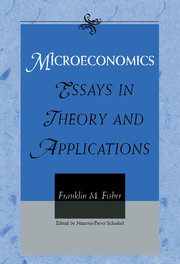Book contents
- Frontmatter
- Contents
- Introduction
- Part I Disequilibrium and Stability
- 1 The Formation of Economic Magnitudes: Disequilibrium and Stability (1990)
- 2 Quasi-Competitive Price Adjustment by Individual Firms: A Preliminary Paper (1970)
- 3 Stability and Competitive Equilibrium in Two Models of Search and Individual Price Adjustment (1973)
- 4 On Price Adjustment without an Auctioneer (1972)
- 5 Quantity Constraints, Spillovers, and the Hahn Process (1978)
- 6 On Stability Analysis with Disequilibrium Awareness (1988)
- 7 It Takes t* to Tango: Trading Coalitions with Fixed Prices (1989)
- 8 An Alternate Proof and Extension of Solow's Theorem on Nonnegative Square Matrices (1962)
- 9 Choice of Units, Column Sums, and Stability in Linear Dynamic Systems with Nonnegative Square Matrices (1965)
- 10 A Simple Proof of the Fisher–Fuller Theorem (1972)
- 11 Gross Substitutes and the Utility Function (1972)
- Part II Welfare Economics and Consumer Theory
- Part III Applications of Microeconomic Theory
- Part IV Industrial Organization, Economics, and the Law
- Part V Public Policy Applications
- Epilogue
- Indexes
7 - It Takes t* to Tango: Trading Coalitions with Fixed Prices (1989)
Published online by Cambridge University Press: 20 March 2010
- Frontmatter
- Contents
- Introduction
- Part I Disequilibrium and Stability
- 1 The Formation of Economic Magnitudes: Disequilibrium and Stability (1990)
- 2 Quasi-Competitive Price Adjustment by Individual Firms: A Preliminary Paper (1970)
- 3 Stability and Competitive Equilibrium in Two Models of Search and Individual Price Adjustment (1973)
- 4 On Price Adjustment without an Auctioneer (1972)
- 5 Quantity Constraints, Spillovers, and the Hahn Process (1978)
- 6 On Stability Analysis with Disequilibrium Awareness (1988)
- 7 It Takes t* to Tango: Trading Coalitions with Fixed Prices (1989)
- 8 An Alternate Proof and Extension of Solow's Theorem on Nonnegative Square Matrices (1962)
- 9 Choice of Units, Column Sums, and Stability in Linear Dynamic Systems with Nonnegative Square Matrices (1965)
- 10 A Simple Proof of the Fisher–Fuller Theorem (1972)
- 11 Gross Substitutes and the Utility Function (1972)
- Part II Welfare Economics and Consumer Theory
- Part III Applications of Microeconomic Theory
- Part IV Industrial Organization, Economics, and the Law
- Part V Public Policy Applications
- Epilogue
- Indexes
Summary
Introduction
The basic assumption of the Edgeworth non-tâtonnement process is that trade takes place if and only if there exists a coalition of agents able to make a Pareto-improving trade among themselves at current, disequilibrium prices. In or out of the Edgeworth-process context, this seems an attractive assumption. There are, however, objections to it (Fisher (1976, p. 12), (1983, pp. 29–31)). One of these is that the formation of such coalitions may impose very high information requirements. In particular, a very large number of agents may have to find each other. In reply to this, David Schmeidler has observed (in a private communication) that such trading coalitions need never involve more members than the number of commodities, while Paul Madden has shown that, if all agents always have strictly positive endowments of all commodities, then such coalitions need never have more than two members. (Both results can be found in Madden (1978).)
These are not very reassuring answers to the problem at hand, however, particularly if one thinks of extending the Edgeworth-process assumption to relatively realistic settings. If consumption takes place at different times, then the same commodity at different dates will be treated as different commodities. This can easily make the number of commodities much greater than the number of agents in the economy. As for Madden's bilateral trade result, it requires strictly positive endowments of all commodities for all agents, and this is far too strong a requirement in the context of disequilibrium trade.
- Type
- Chapter
- Information
- MicroeconomicsEssays in Theory and Applications, pp. 143 - 160Publisher: Cambridge University PressPrint publication year: 1999



